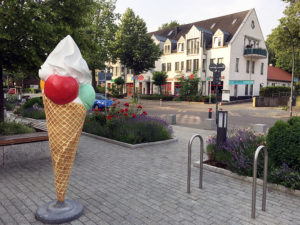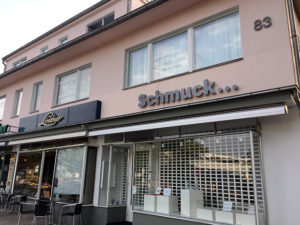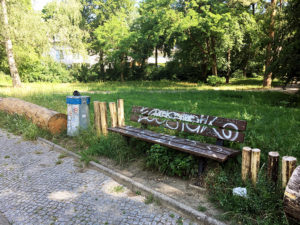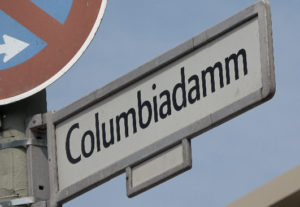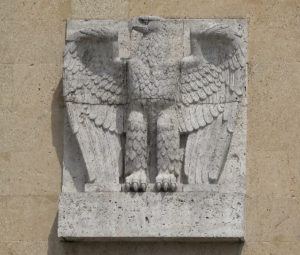We left Zehlendorf on Saturday, 15 June, and got a quick, condensed tour of the former U.S. section of occupied Berlin.
Before we went on the tour, however, I wandered down the street to an ATM to get some euros. Below are a couple of photos from the shopping area maybe a kilometer from the hotel.
The ice cream cone is pretty obvious, but I was a little surprised to see a store called “Schmuck.” I later learned, though, that however Yiddish might translate the word :), it means “jewelry, adornment” in German.
Throughout our visit to Berlin, I was disappointed to see the amount of “tagging.” Maybe not as much as in 1970s New York City, but a lot. Graffiti is technically illegal in Germany, but perhaps “street art” is forgiven. Whatever, I’m generally not a fan. Here’s a scene from my walk.
We met up with Christoph Krajewski, a friend of Isabel’s and a professional guide. He was kind enough to give us the tour free of charge. Chris had been born in Berlin in 1943, so he certainly had the local background and was very informative. We were also joined by Heiko Suhr, military historian, who is working on a book and documentary about Wilhelm Canaris.
As it was the American sector, some of the streets bear American names, presented in German style, such as the signage below. (One of my alma maters.)
Germany and the U.S. share the eagle as a national symbol. This representation was quite common in the area we toured.
The tour was conducted mostly by car, with few stops. We had a lot to cover. Some of the video below was shot from the moving car. Following the tour, we met Michael Günther at the Alliiertenmuseum (Allied Museum), which offers WWII historical items from American, English, and French forces. Michael interviewed me on camera for possible use in the documentary.
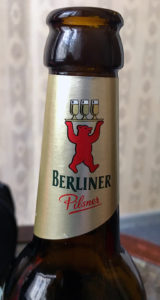 The video (2:09) ends with one of the first “buddy bears” I saw in Berlin. A standing bear has been part of the Berlin identity for centuries. (You’ll see it on the picture of the city hall in 1963, and on bottles of Berliner pilsner.) In 2001, two art students did a street art project, designing and building a bear with a friendly mien. Now they are almost ubiquitous, with different colors and designs to convey a message. Okay, this is street art I like. You’ll see more buddy bears in other videos, too. (I was very disappointed at not being able to find an option that one could inflate to real buddy bear size.)
The video (2:09) ends with one of the first “buddy bears” I saw in Berlin. A standing bear has been part of the Berlin identity for centuries. (You’ll see it on the picture of the city hall in 1963, and on bottles of Berliner pilsner.) In 2001, two art students did a street art project, designing and building a bear with a friendly mien. Now they are almost ubiquitous, with different colors and designs to convey a message. Okay, this is street art I like. You’ll see more buddy bears in other videos, too. (I was very disappointed at not being able to find an option that one could inflate to real buddy bear size.)

